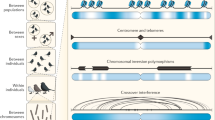Abstract
AT the 1954 Oak Ridge Symposium on Genetic Recombination, I proposed a model of the chromosome in which the molecules of deoxyribonucleic acid projected as side-chains from the main protein axis of the chromosome1. The advantages of such a model for explaining the results of cross-over studies involving closely linked markers were briefly discussed at one of the sessions of the 1956 Cold Spring Harbor Symposium on Genetic Mechanism. In this model, the genes (deoxyribonucleic acid) are linearly arranged along the chromosome; however, the linearity within the gene is not continuous with, or a part of, the linearity between genes. Intergenic cross-overs would be of the classical type involving exchanges of whole segments of the chromosome, whereas intragenic cross-overs would not exchange other markers on the chromosome. According to this conception, the chromosome is composed of alternate sections of deoxyribonucleic acid and protein. To satisfy the requirement for chromosomal continuity it was suggested that the two chains of the Watson–Crick deoxyribonucleic acid double helix are tied together at the free end. Taylor2 has published a chromosome model that differs from mine in that the chromosomal elements are tied together at the other end of the deoxyribonucleic acid instead by making the backbone continuous. In this communication I propose to consider three lines of evidence that may serve to distinguish between these two models.
This is a preview of subscription content, access via your institution
Access options
Subscribe to this journal
Receive 51 print issues and online access
$199.00 per year
only $3.90 per issue
Buy this article
- Purchase on Springer Link
- Instant access to full article PDF
Prices may be subject to local taxes which are calculated during checkout
Similar content being viewed by others
References
Schwartz, D., J. Cell. Comp. Physiol., 45 (Supp. 2), 171 (1955).
Taylor, J. H., Amer. Naturalist, 91, 209 (1957).
Stadler, L. J., and Uber, F. M., Genetics, 27, 84 (1942).
Kirby-Smith, J. S., and Craig, D. L., Genetics, 42, 176 (1957).
Shore, V. G., and Pardee, A. B., Arch. Biochem. and Biophys., 62, 355 (1953).
Taylor, J. H., Woods, P. S., and Hughes, W. L., Proc. U.S. Nat. Acad. Sci., 43, 122 (1957).
Atwood, S. S., La Cellule, 46, 391 (1937).
Kuwada, Y., Cytologia, 10, 213 (1939).
Nebel, B. R., Cold Spring Harbor Symposia Quant. Biol., 9, 7 (1941).
Manton, I., Amer. J. Bot., 32, 342 (1945).
Swanson, C. P., Proc. U.S. Nat. Acad. Sci., 33, 229 (1947).
La Cour, L. F., and Rutishauser, A., Chromosoma, 6, 696 (1954).
Sax, K., and King, E. D., Proc. U.S. Nat. Acad. Sci., 41, 150 (1955).
Taylor, J. H., Genetics, 42, 400 (1957).
Author information
Authors and Affiliations
Rights and permissions
About this article
Cite this article
SCHWARTZ, D. Deoxyribonucleic Acid Side-Chain Model of the Chromosomes. Nature 181, 1149–1150 (1958). https://doi.org/10.1038/1811149a0
Issue Date:
DOI: https://doi.org/10.1038/1811149a0
This article is cited by
-
Chromosome structure: A test of the bineme model
Chromosoma (1975)
-
Electron microscopic observations on interband fibrils in Drosophila salivary chromosomes
Chromosoma (1967)
-
The fine structure of chromosomes in pigeon spermatocytes
Chromosoma (1962)
Comments
By submitting a comment you agree to abide by our Terms and Community Guidelines. If you find something abusive or that does not comply with our terms or guidelines please flag it as inappropriate.



